Peonies "Karl Rosenfeld": description of the variety and features of its cultivation
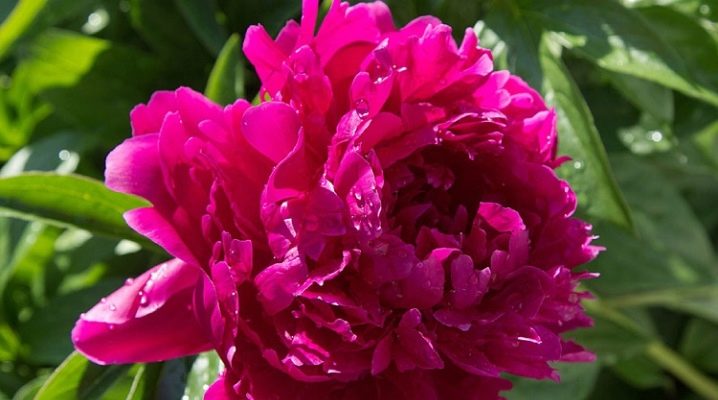
Peonies are common garden perennials. They feel great in different climatic zones and can grow in one place for decades, delighting with their grace and pleasant aroma.
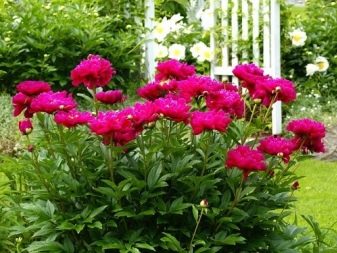
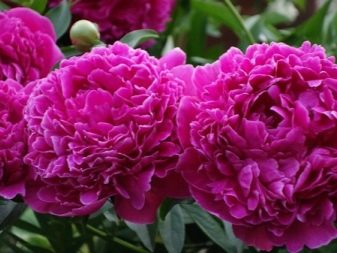
Description
The Karl Rosenfeld variety is rightfully considered one of the most beautiful varieties. It was first bred in China, but due to its splendor and ease of care, it has become very popular in many regions of the world. It belongs to the milky-flowered species, has a large rhizome with powerful fleshy shoots. An adult plant is a lush, spreading bush about 1 meter high with shiny openwork foliage. At the beginning of the season, the leaves are light green, and by late autumn they acquire a dark green tint with a crimson tint.
The inflorescences are bright, double, reaching 14-20 centimeters in diameter. The most cultivated are ruby and purple hues, but there are also variations with red, pink and even white tones.
In central Russia, it blooms for about a month, from June to July. Delicate sweetish aroma is characteristic.
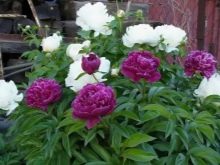

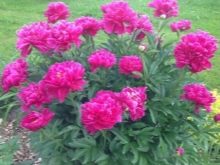
Purchase
Planting material is presented in two types. Most often these are divisions - cut parts of the root with buds and adventitious branches. You can also find potted seedlings on sale. Planting material can be purchased in specialized stores, markets, some supermarkets, or ordered from the online store. It is preferable, of course, to make a purchase where you can visually verify the quality of the garden assortment. When placing an order on the seller's website, be sure to study customer reviews.
When buying a cut, you should pay attention to the presence of a strong root with 2-4 branches, 3-5 buds and adventitious roots 17-20 centimeters long. It is worth inspecting the cuts: if they are wet and rotting, then there is no point in spending money on a low-quality product. Most likely, such specimens were not treated with antiseptics, an infection got into them, and they will not be able to take root. When purchasing seedlings in a pot, it is important to make sure that the root and stem systems are intact so that there are no problems when transplanting into open ground.
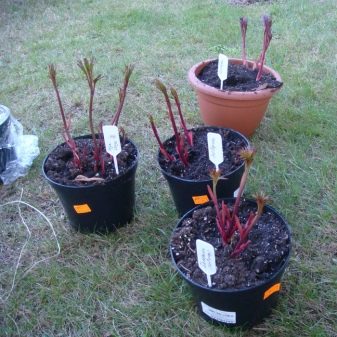
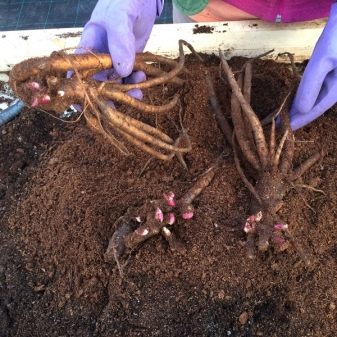
Choosing a landing site
There are no particular difficulties in growing. It grows well in any soil, although cultivated loamy soil is the best option. It is demanding on moisture, but it is inappropriate to place it in damp areas, where there may even be a short stagnation of water. From excessive moisture, rot appears on the roots, which contributes to the death of the culture. It should be planted away from trees so that the roots do not interfere with each other's development.
It should also be taken into account that "Karl Rosenfeld" is photophilous, therefore it is undesirable to plan its planting in shaded areas. In the shade, it will wither and will not be able to delight with its flowering.
It is advisable to choose an open sunny area where air will circulate well, but there will be no draft.
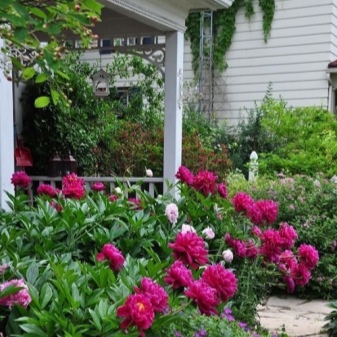
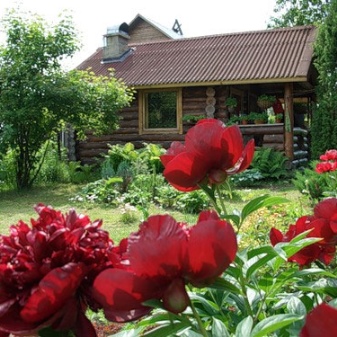
Landing rules
- Planting time is April and September.
- The planting pit should be 50 centimeters long and 50 centimeters wide. Compost and humus are placed on its bottom layer, 1-2 glasses of double superphosphate and the same amount of wood ash are added. The resulting mixture is mixed. You can simply fill the middle layer with garden soil and start planting.
- The plant is placed in the center of the pit, so that the buds are at the top, and the spare roots are horizontal or slightly oblique. It is very important that the depth of the buds is no more than 5 centimeters, otherwise the bush will not be able to bloom for a long time.
- The top layer is very carefully and neatly filled with earth and compacted with your hands, you cannot trample it down with your feet. A roller is formed around the hole from the soil, and watering is performed. If the soil subsides, it is advisable to add a little more earth from above. If you plan to plant a group of peonies, the optimal distance between the grooves should be about 1 meter, so as not to interfere with their successful rooting and growth.
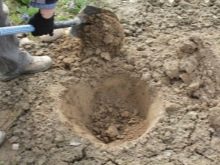

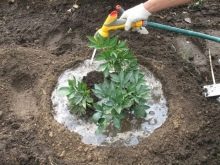
Specificity of care
The perennial will not bloom in the first year, since all forces are directed to the growth of the leaf mass. It is not necessary to water often, but at the same time it is very abundant, about 2 buckets of water. A young shoot should not be allowed to bloom, so the buds that appear on it are cut off. This is necessary so that in a year he gains the necessary strength to form a healthy, strong and abundantly flowering bush in the future.
Within two years after planting, additional fertilizing is not needed, those that were introduced initially are enough. After flowering (usually after 2-3 years), it is advisable to use special fertilizers. The soil must be loosened as a preventive measure against overgrowth of weeds. At the onset of late autumn, the stems are recommended to be cut flush with the ground. She does not need shelter for the winter.
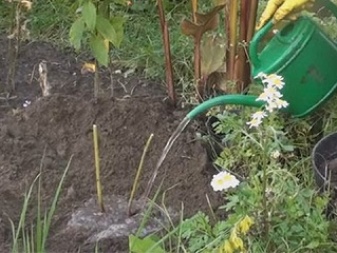

Features of reproduction and transplantation
Propagated by seed and vegetative method. The best way is to divide the bush. Reception allows you to divide it into parts if the age reaches 8-10 years. It is better to carry out the division at the end of August or in September. The overgrown culture must be carefully dug out of the ground, carefully remove the soil from the rhizomes. Further, it is imperative to rinse the roots with water and divide into shares so that on each new rhizome there are 3-5 buds about 7 centimeters long and 3 adventitious roots. The resulting cuttings for disinfection are treated with a solution of potassium permanganate.
Planting can be done only after a few days, since the slices need to dry out in order to prevent further decay. It is impossible to place them on the old flower bed; for transplanting, you must definitely choose a new bed. Seed propagation is considered less effective due to the long wait for the buds to appear. The peony will bloom with this form of planting no earlier than 5 years later. Basically it is used only by breeders. When transplanted by division, flowers appear in the second or third year.
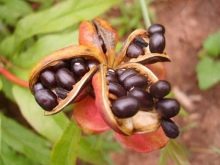
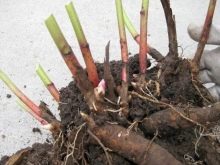

Pests
Ants pose a threat to this variety. For them, the sweet syrup secreted by the inflorescences is very attractive. In an effort to feast on them, pests eat up the petals and leaves of the plant. Among other things, they can infect it with bacteria, as a result of which the appearance of flowers will slow down.
To combat ants, it is necessary to periodically spray the plant and the soil around it with repellents.
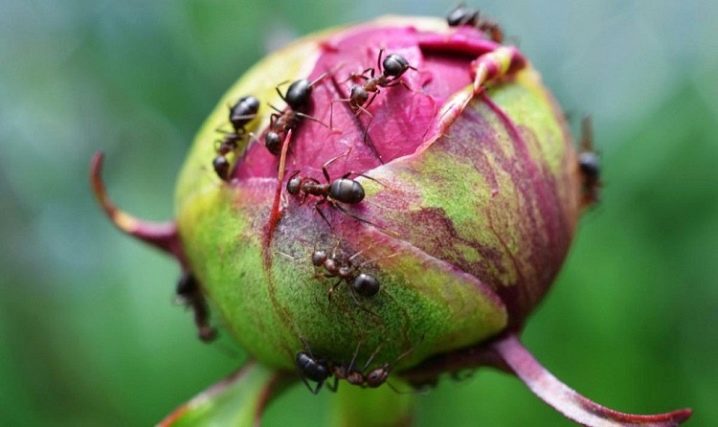
Decoration in the interior of the garden
Due to its attractiveness, this variety often decorates not only private gardens, but also city flower beds, parks, squares. Whatever place the peony takes, it will look great everywhere. It can be grown both singly and as part of a whole group.
This species gets along well with most horticultural crops and is suitable for creating mixed compositions. To emphasize the beauty of the herbaceous peony, it is recommended to plant irises, poppies, bells to it. It will look good in a floral ensemble with yellow daylilies, blue sage, honeysuckle bushes. "Karl Rosenfeld" can add volume and splendor to any flower garden, and after flowering, it can serve as an excellent background for other plants.
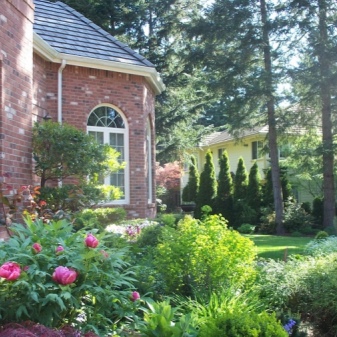

Gardeners reviews
Gardeners give positive assessments of the varietal qualities of the species, while they note that the flowering period depends on weather conditions. In the southern regions, "Karl Rosenfeld" dissolves its petals in May-June, in temperate latitudes - in the second half of June and early July.
They also emphasize that this variety is very photophilous, therefore it is strongly advised to plant it only on the sunny side of the site. In places with partial shade, flowering is slower, and fewer buds are formed. Ease of care and eye-catching beauty of a perennial will appeal to even a novice florist.
For information on how to properly care for peonies, see the next video.







































































































The comment was sent successfully.